
A locomotive or engine is a rail transport vehicle that provides the motive power for a train. If a locomotive is capable of carrying a payload, it is usually rather referred to as a multiple unit, motor coach, railcar or power car; the use of these self-propelled vehicles is increasingly common for passenger trains, but rare for freight.

A diesel locomotive is a type of railway locomotive in which the prime mover is a diesel engine. Several types of diesel locomotives have been developed, differing mainly in the means by which mechanical power is conveyed to the driving wheels.

The British Rail Class 47 or Brush Type 4 is a class of diesel-electric locomotive that was developed in the 1960s by Brush Traction. A total of 512 Class 47s were built at Brush's Falcon Works in Loughborough and at British Railways' Crewe Works between 1962 and 1968, which made them the most numerous class of British mainline diesel locomotive.

In rail transport, head-end power (HEP), also known as electric train supply (ETS), is the electrical power distribution system on a passenger train. The power source, usually a locomotive at the front or 'head' of a train, provides the electricity used for heating, lighting, electrical and other 'hotel' needs. The maritime equivalent is hotel electric power. A successful attempt by the London, Brighton and South Coast Railway in October 1881 to light the passenger cars on the London to Brighton route heralded the beginning of using electricity to light trains in the world.

A gas turbine locomotive is a type of railway locomotive in which the prime mover is a gas turbine. Several types of gas turbine locomotive have been developed, differing mainly in the means by which mechanical power is conveyed to the driving wheels (drivers). A gas turbine train typically consists of two power cars, and one or more intermediate passenger cars.

Dieselisation is the process of equipping vehicles with a diesel engine or diesel engines. It can involve replacing an internal combustion engine powered by petrol fuel with an engine powered by diesel fuel, as occurred on a large scale with trucks, buses, farm tractors, and building construction machinery after the Second World War. Alternatively it can involve replacing the entire plant or vehicle with one that is diesel-powered; the term commonly describes the generational replacement between the 1930s and the 1970s of railway steam locomotives with diesel locomotives, and associated facilities.

The M62 is a Soviet-built diesel locomotive for heavy freight trains, exported to many Eastern Bloc countries as well as to Cuba, North Korea and Mongolia. Beside the single locomotive M62 also twin versions 2M62 and three-section versions 3M62 have been built. A total number of 7,164 single sections have been produced, which have been used to build 5,231 single-, twin- and three-section locomotives.

SU42 is a Polish diesel-electric locomotive used for light freight and passenger traffic purposes.
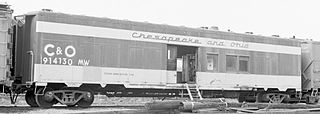
A steam generator is a type of boiler used to produce steam for climate control and potable water heating in railroad passenger cars. The output of a railroad steam generator is low pressure, saturated steam that is passed through a system of pipes and conduits throughout the length of the train.
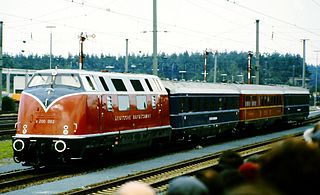
DB Class V 200 was the first series production diesel-hydraulic express locomotive of the German Deutsche Bundesbahn and – as Am 4/4 – of the SBB-CFF-FFS in Switzerland.
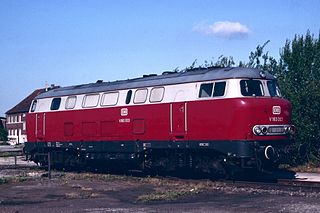
The Class V 160 is a class of diesel-hydraulic locomotives of the German railways. It is the first variant of the V160 family, built for the Deutsche Bundesbahn for medium/heavy trains.
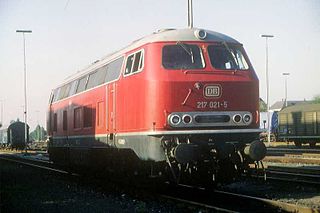
The DB Class V 162 is a class of four-axle diesel hydraulic locomotive built as a development of the DB Class V 160 for the Deutsche Bundesbahn from 1965 to 1968.

The DB Class 215 is a 4 axle diesel locomotive of the V 160 type. They were built for the German Federal Railways for medium-weight passenger and freight service on secondary and primary routes, and later passed to the Deutsche Bahn AG.

The DB Class 218 are a class of 4-axle, diesel-hydraulic locomotives acquired by the Deutsche Bundesbahn for use on main and secondary lines for both passenger and freight trains.
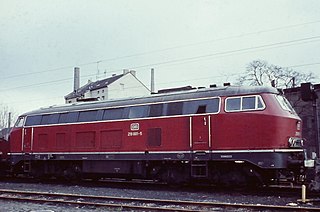
The DB Class V 169 consisted of a single example: V 169 001, derived from the DB Class V 160 family, with an additional gas turbine booster engine. It can be considered the prototype for diesel locomotives with a gas turbine as an additional drive; specifically the DB Class 210. Post 1968 the class designation was changed to Class 219, and the locomotive renumbered 219 001

The DR 130 family of locomotives comprises the DR Class 130, DR Class 131, DR Class 132 and DR Class 142, in USSR locomotive called TE109 and TE129.
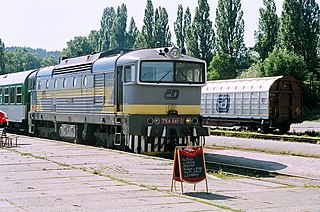
T478.4 is a class of diesel locomotives designed, manufactured and used in the former Czechoslovakia and now used in the Czech republic and Slovak republic. The locomotive is based on the T478.3 locomotive series. The most important difference was an electric train heating generator instead of the steam heating generator used on T478.3. To provide additional power needed for the heating generator, the prime mover power output was increased to 1470 kW, but the maximal power at the output of the traction generator remained the same as on Class T478.3. Another important new technology used on these locomotives was an electronic control system with an electrically controlled air brake valve and an automatic speed regulator, which was able to control not only the power output, but also the air brake. Their distinctive cab design has led to the nickname "Brejlovec" ("Goggles").

The Indian locomotive class WDM-4 is a class of diesel-electric locomotive that was developed in 1962 by Electro-Motive Diesel for Indian Railways. The model name stands for broad gauge (W), Diesel (D), Mixed traffic (M) engine, 4th generation (4). They entered service in 1962. A total of 72 WDM-4 locomotives were built between 1961 and 1962.

The SNCF Class CC 72000 was a class of C′C′ diesel-electric locomotives designed and built by French manufacturing conglomerate Alsthom. They are regarded as being the most powerful class of diesel locomotives to be built in France.
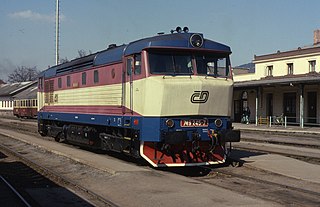
The ČD 749 class is a diesel electric locomotive, created through refurbishment of classes 751 and 752.




























